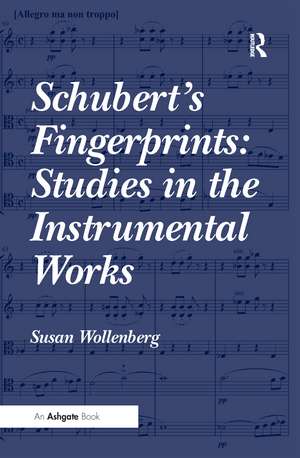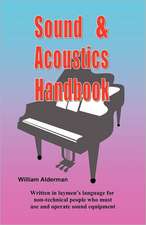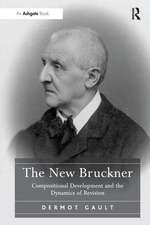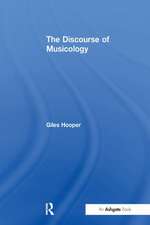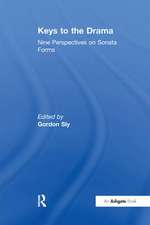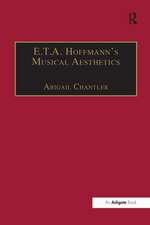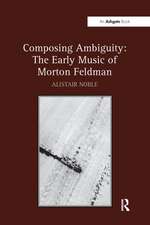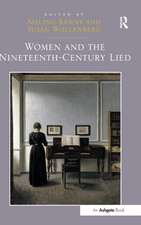Schubert's Fingerprints: Studies in the Instrumental Works
Autor Susan Wollenbergen Limba Engleză Paperback – 9 sep 2016
| Toate formatele și edițiile | Preț | Express |
|---|---|---|
| Paperback (1) | 489.26 lei 6-8 săpt. | |
| Taylor & Francis – 9 sep 2016 | 489.26 lei 6-8 săpt. | |
| Hardback (1) | 1116.31 lei 6-8 săpt. | |
| Taylor & Francis – 28 noi 2011 | 1116.31 lei 6-8 săpt. |
Preț: 489.26 lei
Nou
Puncte Express: 734
Preț estimativ în valută:
93.62€ • 100.11$ • 78.06£
93.62€ • 100.11$ • 78.06£
Carte tipărită la comandă
Livrare economică 18 aprilie-02 mai
Preluare comenzi: 021 569.72.76
Specificații
ISBN-13: 9781138245709
ISBN-10: 1138245704
Pagini: 344
Dimensiuni: 156 x 234 x 24 mm
Greutate: 0.45 kg
Ediția:1
Editura: Taylor & Francis
Colecția Routledge
Locul publicării:Oxford, United Kingdom
ISBN-10: 1138245704
Pagini: 344
Dimensiuni: 156 x 234 x 24 mm
Greutate: 0.45 kg
Ediția:1
Editura: Taylor & Francis
Colecția Routledge
Locul publicării:Oxford, United Kingdom
Notă biografică
Susan Wollenberg is Professor of Music at the University of Oxford, Faculty of Music, and Fellow and Tutor of Lady Margaret Hall, as well as Lecturer in Music at Brasenose College. Among her publications are contributions on Schubert to various journals and symposia including Schubert Studies, ed. Brian Newbould (Aldershot: Ashgate, 1998), and Schubert durch der Brille, Journal of the International Schubert Institute (2002 and 2003). Her paper given at the international Schubert bicentenary conference in Paris (1997) appeared as 'Schubert's Poetic Transitions' in Le style instrumental de Schubert: Sources, analyse, évolution, ed. Xavier Hascher (2007).
Recenzii
'In the ongoing project to refute earlier writers' characterization of Schubert as "less than Beethoven", Susan Wollenberg's analytical study is among the most important new entrants into the field. Everyone who listens to Schubert's instrumental compositions soon becomes aware of a unique style, one composed of an intricate mesh of particular rhythmic and metrical practices, formal procedures, tonal processes, harmonic thumbprints, and much more. Wollenberg devotes a chapter to each of Schubert's foremost predilections, with - one of this book's many strengths - ample attention to exceptions. Those who read this beautifully written book will emerge from it with a much greater understanding of what makes Schubert so great.' Susan Youens, University of Notre Dame, USA 'Those in the fields of musicology and music theory who are studying Schubert or who have a scholarly focus on the music will welcome this important new contribution to Schubert research... Highly recommended.' Choice 'This book organizes and develops the discussion of various areas of Schubert’s style in new directions. Freed from the pre-conceptions of the Beethovenian aesthetic, Schubert is allowed to be assessed as a master composer on his own terms. This is recommended reading for all who wish to stay abreast of modern Schubert scholarship.' The Schubertian 'Wollenberg’s authoritative and richly detailed attempt to put several of Schubert’s most distinctive fingerprints under the analytical microscope results in a valuable contribution to our understanding of a composer whose formal complexity and coherence remain relatively unexplored.' Notes '... erudite and enlightening...' The Musical Times '... what shines through on every page is Wollenberg’s deep knowledge of Schubert’s music, as she draws subtle connections across the history of his output. Her numerous reconstructions of what Schubert might have written, had he been inclined to follow common practice, illuminates what make
Cuprins
List of Figures, List of Music Examples, Acknowledgements, List of Abbreviations, Note on the Format of Music Examples and Figures, 1. Introduction, 2. ‘His Favourite Device’: Schubert’s Major–Minor Usage and its Nuances, 3. Poetic Transitions, 4. Schubert’s Second Themes, 5. Schubert and Mozart, 6. Schubert’s Violent Nature, 7. Threefold Constructions, 8. Schubert’s Variations, 9. ‘Heavenly Length’, 10. Concluding Remarks: ‘Whose Schubert?’, Select Bibliography, Chronology of Schubert’s Instrumental Works Discussed, Index of Schubert’s Works, General Index
Descriere
As Robert Schumann put it, 'Only few works are as clearly stamped with their author's imprint as his'. This book explores Schubert's stylistic traits in a series of chapters each discussing an individual 'fingerprint' with case-studies drawn principally from the piano and chamber music. Schubert emerges as someone exerting intellectual control over his musical material and imbuing it with poetic resonance.
